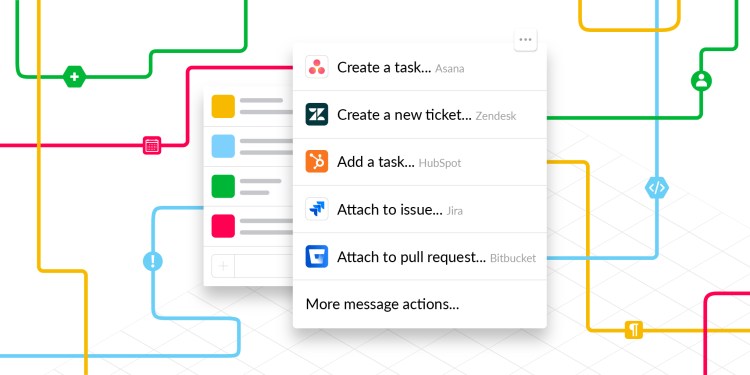Watch all the Transform 2020 sessions on-demand here.
Slack today made one of its biggest changes to date to its platform with the introduction of actions, an enhancement to integrations from third-party software providers. Once a task is completed with an action, a bot can then share updates in a Slack channel. More than 90 percent of Slack’s 3 million paid users regularly use apps and integrations.
Actions launch initially with deeper integrations to create a task in Asana or HubSpot, make a pull request with Bitbucket, or quickly complete tasks with Zendesk or Atlassian’s Jira. Actions from read-later app Pocket and productivity app ToDo are coming soon.
Actions can be brought up with a click or tap of any Slack message and are being made available to all developers using the platform to deploy bots and integrations starting today. The announcement was made at Spec, Slack’s developer conference in San Francisco.
The new feature brings enterprise developers deeper into Slack, following the introduction of app drop-down menus and buttons.
June 5th: The AI Audit in NYC
Join us next week in NYC to engage with top executive leaders, delving into strategies for auditing AI models to ensure fairness, optimal performance, and ethical compliance across diverse organizations. Secure your attendance for this exclusive invite-only event.
Actions require no slash commands, a sign that the Slack Platform has matured, chief product officer April Underwood told a gathering of reporters.
“Many of the apps represented here, as well as others, had capabilities where you could add something to a ticket or create a task, but they were slash commands, and one of the things we have definitely learned as Slack has been adopted by now 8 million daily active users and gone way beyond tech teams is that slash commands aren’t the easiest form of discovery for a lot of people,” Underwood said. “So this is the first time we’ve ever actually exposed some real surface area inside the messaging experience in Slack and offered that up to third parties.”

Above: Creating a ticket with the Zendesk action
The deployment of actions is part of a partnership between Slack and the creators of some of the platform’s most popular SaaS integrations, according to Slack VP Brad Armstrong. Each of the partners insists that the deeper integration of SaaS software into Slack is a recognition of the amount of time people spend in the chat app and an acknowledgment that employees, not managers, choose what software they like using to get their job done.
“The world has changed dramatically. Users have choice in the enterprise space as well, and they’ll vote with their actions in terms of what they want, so what we’re building is the ability for these systems to interoperate with each other because it’s what the user wants,” Slack Platform general manager Brian Elliott told VentureBeat.
Asana head of product Alex Hood said he isn’t worried about users of the team productivity software spending too much time in Slack instead of Asana.
“I think less about which UI you’re in and more around the customer benefit that we’re delivering around clarity,” he said. “Over half of our customers at Asana use Slack, so it’s very high demand that this integration be super seamless and you can do things traditionally done in Slack in Asana and the other way around.”
Actions will initially be displayed based on what individuals use most frequently. In the future, predictive AI models will be deployed to determine which actions are displayed based on things like patterns of usage, organization size, and other characteristics, Elliott said.
Slack, a chat app initially made by a gaming company, launched in 2014 and first made the Slack Platform available in December 2015. Slack now attracts 8 million daily active users, up from 3 million in May 2016. The Slack App Directory now has 1,500 bots and workplace services.
Also announced today: The Slack Fund has invested in six additional companies making workplace experiences for the Slack Platform, including workplace assistant Clara, SaaS management service Zylo, and edtech startup Learnmetrics.

Above: Creating a task with the HubSpot action
By bringing SaaS tools commonly used to carry out tasks to each message sent, Underwood said, actions were designed to increase interoperability between teams within a company that often work together but may be concentrated in their own team silos.
“When you think about that, no operating system does that, no browser that, none of the existing wrappers around all your different tools actually enables this sort of interoperability. So it’s not just about all of these folks integrating with the messaging layer for Slack — they are ultimately using messaging as a conduit to integrate with each other and allow basically an unlimited number of configurations and workflows within teams,” she said.
Actions will first be rolled out for the Slack desktop app over the course of the next month. Actions for Slack iOS or Android apps will be shared at a later date.


